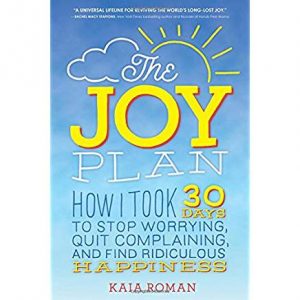
By Kaia Roman
Where is our joy located? It’s an odd question. Especially during these past few weeks. Perhaps you think joy is in your heart, or maybe you experience joy as a state of mind.
It turns out, according to scientists, joy originates in the limbic system of the brain—the part of the brain that controls emotion, behavior, and long-term memory. Unlike happiness, which is a cognitive experience based in the brain’s neocortex, joy is an emotion we feel without conscious thought. We feel joy without thinking about it, and we can train our brains to feel it often.
EMOTIONS ARE HABITUAL
Just like any repetitive action, our emotional state becomes a habit. For most of my life, my emotional habit was some version of fear. From the time I was a small child, I was a perpetual worrier. I have a vivid memory of being 4 years old in a restaurant with my mom and her then-boyfriend, who happened to be a professional clown. The clown was entertain-ing, the meal was my favorite, but I couldn’t stop worrying about everything.
“Just relax, Kaia!” my mom implored me. “I’m trying as hard as I can!” I wailed. This is the story of my life. Although my outside often looked like the Garden of Eden, my inside often felt like Armageddon.
YOUR BRAIN ON FEAR
Our amygdala, the fear center in our brains, responds to perceived stress with the primal reactions of fight, flight, and freeze. When the amygdala is active, to be sure we have all the brain power we need to carry out this instinctual response, it limits activity in the prefrontal cortex, which happens to be where logical thought, clear decisions, and rational choices are generated.
We simply can’t do our best thinking and best problem solving when we’re in a state of fear.
Fear also turns on the sympathetic nervous system—the body’s project manager for the fight-or-flight response—which releases hormones, such as adrenaline, noradrenaline, and cortisol, to pump us up for battle. The sympathetic nervous system accelerates our heart rate, increases blood pressure, slows digestion, constricts blood vessels, dilates the pupils, and can cause tunnel vision, shaking, and a number of other physical symptoms.
Our bodies are incredible mechanisms with systems like this in place to help us stay safe, which is wonderful when we’re in danger. But here’s the catch: We can’t sustain high levels of fear for too long before our adrenal glands become depleted, our cells deteriorate from an overabundance of cortisol, and we become exhausted and sick.
THE JOY PLAN
I finally hit rock bottom shortly before my 40th birthday. I’d been making plans since I could talk, but I found myself examining what the point of all my planning really was.
Ultimately, I simply wanted joy and, despite appearances, I rarely felt it.
I knew I needed to break free from the grip of fear which had held me most of my life. So I made my ultimate plan: The Joy Plan, dedicating 30 days to the singular task of rewiring my brain to generate joy—in the hope that one month would change my entire life.
Although I’d read books and blogs for years that told me to “relax,” “think positive,” “stay calm,” “don’t worry, be happy,” I still had no idea how to actually do that. So when I took the Joy Plan on as a full-fledged science experiment, I became determined to utilize the neurobiology behind the experience of joy to my advantage.
What I found, to my delight, was that 30 days is long enough to form new habits, and the most important new habits boiled down to five easy daily actions. You don’t even need to set aside a whole month to give them a try.
Like healthy eating, joy is a habit we must practice regularly (especially in these times) in order to reap the benefits. By intentionally practicing thinking new thoughts, speaking new words, and taking new actions, I changed my experience of life. I am not happy all the time, but that’s not the point. I’ve finally figured out how to live in joy.
Five Daily Actions to Boost Your Joy
- FOCUS ON GRATITUDE: The fastest way to generate joy is to focus on things you appreciate. Every day, make a list, even if it’s in your head, of things for which you’re grateful, even more so now, in these times. Feelings of gratitude release dopamine, a feel-good neurotransmitter in the brain. When you bathe your brain in this chemical experience, you’ll predispose yourself for more.
- PRACTICE MINDFULNESS: Mindfulness is simply the act of bringing your awareness to the present moment. Deep breaths calm the brain’s amygdala and train your brain and body to remain calm in the midst of swirling thoughts and emotions. With even a short daily practice, mindfulness can alter your brain in profound ways. While in self-quarantine, now is a perfect time to start a mindfulness practice.
- BOOST HAPPY HORMONES: Four main neurochemicals generated in the brain are highly influential to the sensations we’ve come to associate with joy: endorphins, serotonin, dopamine, and oxytocin. The good news is these neurochemicals are easy to access through daily actions, such as exercise, spending time outdoors (keeping your distance), smiling more often, and giving hugs. These you can do under quarantine!
- CHOOSE OPTIMISM: Thanks to the process of neuroplasticity, our brains develop neural pathways like well-worn highways they travel on regularly because they’re familiar. By choosing positive thoughts, words and actions at every opportunity—focusing on solutions rather than problems—you’re training your brain to form neural pathways for optimism, which is associated with greater joy.
- GIVE TO OTHERS: Giving is an excellent way to generate joy. Acts of kindness release dopamine, for both the giver and the receiver. You can receive these feel-good benefits from giving something as small as a compliment (even online), to as large as you can imagine. I encourage you head online to UNV Volunteering Service for a chance to volunteer online.
These are challenging times, but we can still maintain our wellbeing if we try. Sending you all healthy vibes.
—
ABOUT

Kaia Roman has been writing books since she was five years old.
She believes in the healing power of words and stories. The Joy Plan is her first memoir/personal growth book. Over the past twenty years, Kaia has been a planner, publicist, ghost writer, and editor for people, projects, and products working toward a better world.
She’s now a full-time writer and frequent blogger on mindbodygreen, The Huffington Post, and other wellness sites. She also has the honor of teaching Mindfulness to elementary school children. When she’s not in another country with her globe-trotting family, Kaia lives in Santa Cruz, California with her wonderful husband and two magical daughters.
—
I posted Kaia’s article today because I thought it armed us with a lot of empowerment and positivity in these stressful times. Let’s all work together and manifest as much joy as we can, even far away from one another, and even in these dark times.




